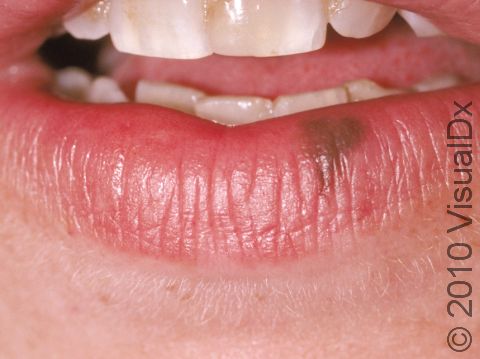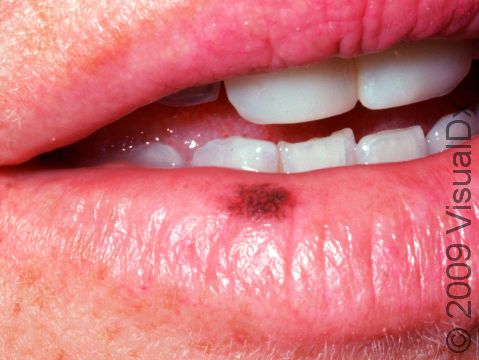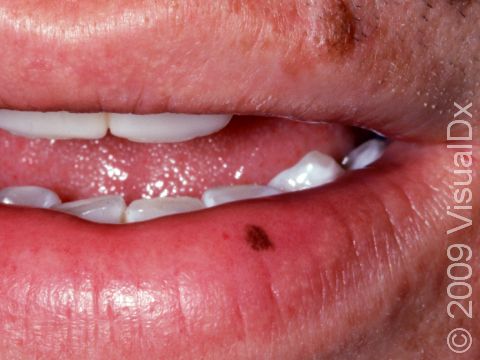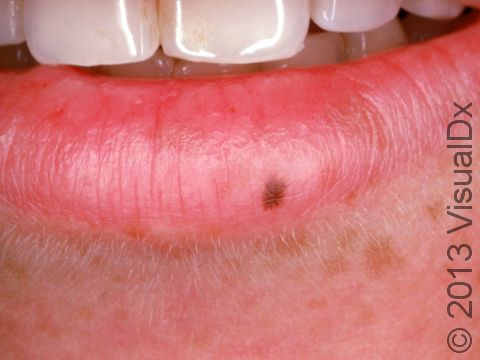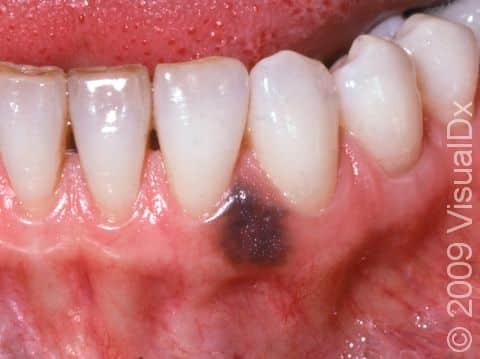Oral Melanotic Macule
Oral melanotic macule is a non-cancerous (benign), dark spot found on the lips or inside the mouth. An oral melanotic macule found on the lip is sometimes called a labial melanotic macule.
Who's At Risk?
Oral melanotic macules can appear in people of any age, of any race, and of either sex. However, they are more common in middle-aged people, in dark-skinned people, and in females.
Signs & Symptoms
The most common locations for an oral melanotic macule include:
- Lips, especially the lower lip
- Gums (gingiva)
- Inner cheek (buccal mucosa)
- Roof of the mouth (hard or soft palate)
An oral melanotic macule appears as a solitary, flat, tan-to-dark-brown spot usually less than 7 mm in diameter. It has a well-defined border and a uniform color.
People can have more than one oral melanotic macule.
Self-Care Guidelines
There are no self-care measures for oral melanotic macules.
Treatments
If the diagnosis of oral melanotic macule is not certain, your physician may wish to perform a skin biopsy in order to confirm the diagnosis. The procedure involves:
- Numbing the skin with an injectable anesthetic.
- Sampling a small piece of skin by using a flexible razor blade, a scalpel, or a tiny cookie cutter (called a “punch biopsy”). If a punch biopsy is taken, a suture or two may be placed and will need to be removed 5–10 days later.
- Having the skin sample examined under a microscope by a specially trained physician (dermatopathologist).
Your doctor is more likely to biopsy certain lesions, such as new ones, large or growing ones, or those with irregular color (pigmentation). The biopsy can help the doctor to tell whether it is a benign oral melanotic macule or a malignant melanoma, a type of skin cancer.
Most dark spots on the lips or inside the mouth are benign oral melanotic macules. Usually, your doctor will observe the lesion by measuring it, by taking a photograph of it, or both. As long as the oral melanotic macule stays stable in size, shape, and color, no treatment is needed.
Nonetheless, some people want the lesion removed for cosmetic reasons. If it is appropriate, some physicians might recommend excision or, rarely, laser treatment.
Visit Urgency
See your doctor for any new dark spot on the lips or inside the mouth. Similarly, any existing spot that changes size, shape, or color should also be evaluated promptly.
Trusted Links
References
Bolognia, Jean L., ed. Dermatology, pp.1094. New York: Mosby, 2003.
Freedberg, Irwin M., ed. Fitzpatrick’s Dermatology in General Medicine. 6th ed, pp.1083. New York: McGraw-Hill, 2003.
Last modified on October 10th, 2022 at 4:22 pm

Not sure what to look for?
Try our new Rash and Skin Condition Finder
